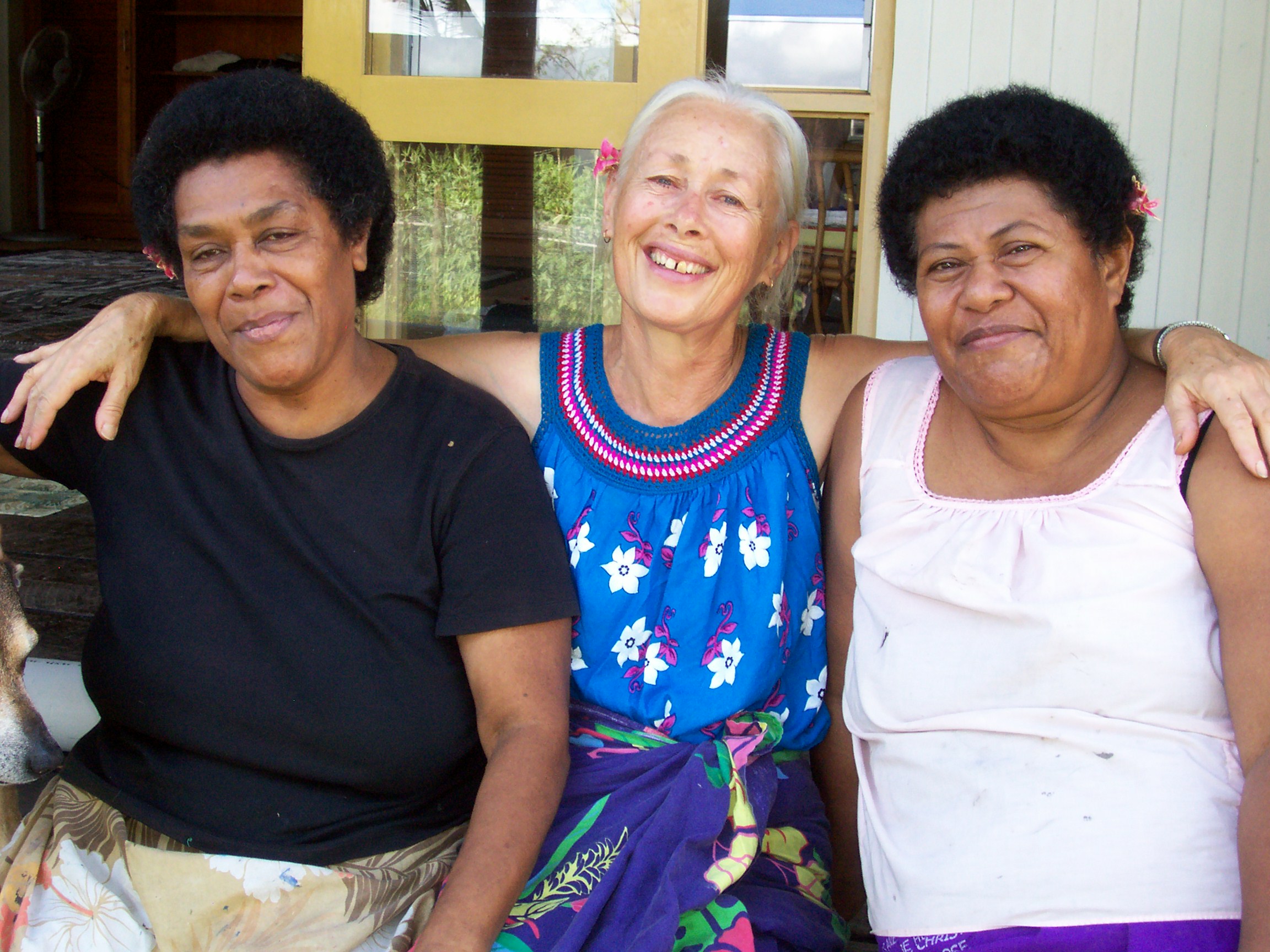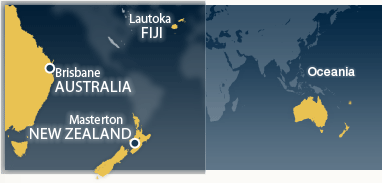
بریزبین، استرالیا — پارچه های سنّتی جزایر پاسیفیک که از الیاف درختان ساخته شده و نقش هائی بر اساس بینشی از «گلستانی نوین» روی آنها چاپ شده بودند از جمله آثار هنری بودند که با سفارش مخصوص برای عرضه در یک نمایشگاه شکوهمند در یک گالری هنری در کوئینزلند ساخته شده بودند.
ششمین دورۀ جشن هنرهای مدرن کشورهای پاسیفیک آسیائی که هر سه سال یکبار برگزار میشود اکنون چهارمین ماه برپائی خود را پشت سر میگذارد که در آن آثار چندی از نامدارترین هنرمندان منطقۀ پاسیفیک به نمایش گذاشته شده.
از هنرمند شایستۀ نیوزیلند، رابین وایت دعوت به عمل آمده بود که در این نمایشگاه شرکت نماید و برگزارکنندگان از همکاری او با هنرمندانی از فیجی برای ساخت پارچه از الیاف گیاهانی مخصوص سخن میگفتند. سرانجام خانم وایت پیشنهاد همکاری با دو تن از اهالی فیجی، لبا توکی و بالی جیون را قبول نمود.
هر سۀ این هنرمندان بهائی بوده از تجسّمشان برای جامعۀ آیندۀ بشر در خلق آثارشان الهام گرفتند.
خانم وایت اظهار نمود که «ما میخواستیم بینشمان را از آنچه که فی جی میتواند باشد - و آنچه که خواهد بود - ارائه نمائیم».
ایشان توضیح داد که در فیجی تقریباً پیروان همۀ ادیان به نسبت قابل توجّهی حضور دارند، هندوها، مسلمانان، بودائیان، مسیحیان و عده ای معدود ولی در حال گسترش از بهائیان.
ایشان گفتند: «این یک مورد ویژه است و ما بر آن بودیم که این ایده را در هنرمان منعکس کنیم».

اهالی فیجی بافت پارچه از الیاف گیاهان و نیز گیاهی که از پوست آن برای این عمل مورد استفاده قرارمیگیرد تاپا مینامند که به طور سنتـّی برای مراسم ازدواج استفاده میشود و این هنرمندان در حقیقت از همین ایده استفاده نمودند.
خانم وایت بیان داشت «نظر ما برگزاری یک ازدواج واقعی بین افراد نبود بلکه ایدۀ ازدواج بین سنت ها، یعنی اهالی بومی و هندوان بود که جامعۀ کنونی فیجی را تشکیل داده و با عشق و احترام به هم مرتبطند».
سرانجام مبانی متفاوتی در بافتۀ آنان تلفیق گردید. قطعۀ اصلی شامل تصویری از مرقد حضرت باب در اراضی مقدسه و تراس های اطراف آن و تصاویری مهم از فیجی را شامل بود.
برای خانم توکی همکاری او، به عنوان یکی از اهالی فیجی برای خلق یک اثر هنری روی پارچه ساخته شده از گیاهان، با فردی دیگر از اهالی نیوزیلند خود یک پیشرفت مهم محسوب میشده.
او اظهار داشت «من میدانستم که تنها اهالی فیجی هنر چارچه بافی با الیاف گیاهان را دارند و از اینرو هنگامی که خانم وایت برای پروژه ای دیگر در گذشته با من تماس گرفت در این اندیشه بودم که چگونه ما میتوانیم با هم همکاری کنیم».
برای خانم وایت ایدۀ چنین همکاری درطی سفرهایش به جزایر پاسیفیک به وجود آمده بود. در عین حالیکه خانم وایت هنرمندی شناخته شده در امور هنری دیگری بود، از هنر بافت پارچه از الیاف گیاهان در فیجی، ساموا و تونگا آگاه بود ولی زمانیکه قطعۀ بسیار زیبائی را در سالن ترانزیت فرودگاه نادی (در فیجی) مشاهده نمود بر آن شد که تکنیک ساخت آنرا فرا گیرد.
ایشان خانم توکی را ابتدا در یک گردهمائی بهائی و سپس در منزلش ملاقات نمود که در آن قطعه ای زیبا از این نوع پارچه به دیوار زده شده بود.
خانم وایت سؤال نمود: «این ها کار کیست؟»
The bark cloth itself comes from the bast, or "skin," of the paper mulberry. The outer bark is discarded, the hard inner stalk is used for firewood or staking plants in the garden, and the skin is dried and stored. When required for making masi, the dry strips are soaked in water and then beaten. The strips are overlaid as they are beaten, as in a felting process.
The inner skin of the dogo, or mangrove, provides the raw material for kesa, the liquid paint used for printing the patterns. A stone is used to pound pieces of dogo, which are then boiled to form the kesa.
The pigment for the paint consists of black soot and brown clay, or umea, that is dried and scraped to make a fine power. To produce the soot, a wick is prepared from scraps of bark cloth. This is dipped into kerosene and burned in an enclosed tin oven. The soot collects on the inside upper surface of the oven and is carefully removed and stored in a tin. The soot is mixed with the kesa and umea to make loloa – black paint.
(Source: Robin White)

زمانی که خانم وایت دریافت که خانم توکی هنرمند این آثار بوده، ایده ای برای همکاری پا گرفت. ابتدا خانم توکی تمایلی به این همکاری نداشت چرا که هرگز نشنیده بود بجز اهالی فیجی فرد دیگری توانائی خلق آثاری همانند کارهای هنری او را دارا باشد. اما زمانی که دریافت خانم وایت یک هنرمند واقعی است با این همکاری موافقت نمود و زمانیکه همکاریشان آغاز شد آنرا ارزشمند یافت.
خانم توکی اکنون میگوید «همکاری بسیار توانبخش است، نژادهای متفاوت هر یک ایده ای را ارائه میکند».
او بیان داشت که روش مشورت، اقدام و تأمل – که به خاطر خدماتشان به عنوان افراد بهائی برای هر سه بسیار آشنا است – نکتۀ کلیدی آنان در خلق اثرهنریشان برای نمایشگاه جشن هنرهای مدرن کشورهای پاسیفیک آسیا بوده است.
این سه هنرمند که اثرشان را ماه ها قبل به اتمام رسانده بودند برای مراسم افتتاح نمایشگاه و شرکت در گفتگوهای درون انگیز با سایر هنرمندان از سایر مناطق پاسیفیک آسیائی به بریزبین مسافرت نمودند.
نمایشگاه تا ۵ آوریل (۱۶ فروردین) ادامه خواهد داشت.

In Fiji, Mrs. Toki lives in Lautoka, known as Sugar City because of a large sugar mill located in the town. The idea of sugar became one of the starting points for the three artists as they developed concepts for their commissioned work.
"Sugar (became) a metaphor for the sweetening of relationships between people," Mrs. White said, explaining how their thinking progressed.
"The real Sugar City is the city of God," she continued.
This image led the artists to picture the Baha'i gardens and terraces on Mount Carmel in Haifa, Israel - gardens known for their beauty and perfection and thus symbolic of a transformed society, Mrs. White said.
"That seemed like a visual framework," she said.
The main tapa they made shows the Baha'i shrine on Mount Carmel with its terraced gardens. At the base is a sugar plantation. Taro – a food staple in the Pacific that is believed to be one of the earliest cultivated plants – is depicted as growing on the terraces.
That tapa is a large wall hanging, 12 by 8 feet, and is accompanied in the exhibition by a second piece for the floor. The artists also created other elements, including the garments for the "wedding," that also will remain part of the collection at the Queensland Art Gallery.
They named the work "New Garden" – "Teitei Vou" in the Fijian language – words taken from the writings of Baha'u'llah.
The art of the tapa
Mrs. White said the artistic decoration of bark cloth remains part of the culture in Fiji.
"Young girls in the Lau group of islands in Fiji, where Leba and Bale come from, all do this kind of tapa work," she explained, "and some become skillful at doing specialized aspects of it such as designing and cutting stencils. In the village setting, the women all work together. If someone is getting married, the women get together to make the tapa."
"It's a sacred cloth," Mrs. White said. Traditionally it has been used for various occasions and now, with the European influence, is used even more extensively – for tablecloths and other items, for example.
For the artwork for APT6, Mrs. Jione acquired the raw material for making the tapa on her native island of Moce and took it to her current home in Suva, the capital of Fiji which is located on the island of Viti Levu.
There she and her husband worked together to beat it into sheets before taking it across the island to Lautoka where Mrs Toki lives. Mrs. White then joined them in Lautoka for a few months – Fiji is a four-hour flight from New Zealand – and the three artists worked together to make the designs and do the painting.
Mrs. Jione said the stenciling is much easier now than in the old days. Her grandmother, for example, used banana leaves for the stencils, but they were difficult to work with and not very durable. Now the artists use X-ray film, and the stencils can be used over and over.
"Because of film, many more people can do the painting," she said.
In the early stages of the APT6 project, Mrs. White spent time reading about Fiji as part of her preparation.
"I did a lot of research into the history," she said. She discovered how the Fiji of today is a result of indentured laborers being brought from India to work on the sugar plantations, and how Mahatma Gandhi supported efforts to bring the human trafficking to an end.
In recognition of this period of history and the suffering associated with it, the size of the main tapa - 12 by 8 feet - was made in the dimensions of the living quarters issued to the Indian laborers who were obliged to live three to a room.
"Everything in the artwork has significance," Mrs. White said.
More about the APT6 exhibition
The Asia Pacific Triennial of Contemporary Art – now in its sixth edition – runs through early April in the Gallery of Modern Art and the Queensland Art Gallery in Brisbane. The exhibition includes 313 artworks by some 160 artists from 25 countries.
This year's show includes for the first time artists from North Korea, Iran, Turkey, Tibet, Cambodia, and Myanmar - a fact that Mrs. White finds significant. The presence of North Korean artists is particularly interesting, she said.
"To see their work included in the APT seems to me a very important thing," she noted.
The Triennial, she said, brings together artists from diverse backgrounds living in the world's largest land mass and scattered across the world's largest ocean.
"I am fascinated with how culture and belief informs their work," she said of the participating artists. Some of the pieces have a deeply spiritual aspect, she said, and some reflect social or political issues.
She noted that a work that is overtly Baha'i perhaps is more accepted and appreciated here than in many other venues.
Queensland Art Gallery Director Tony Ellwood said collaboration among artists of different countries was a hallmark of the exhibition.
"Much of APT6 draws on the extensive network of relationships, within the region and beyond, that has always been integral to the Triennial's spirit," he said.
In addition to the tapa created by the three Baha'is of New Zealand and Fiji, some of the collaborative art projects in APT6 include "The Mekong," a collection of works from Vietnam, Cambodia, Thailand, and Myanmar, and "Pacific Reggae," a selection of Pacific reggae music videos, concert clips, documentaries, and performances.
For information on APT6, go to www.qag.qld.gov.au/apt6
For the page about the three tapa artists, go to http://qag.qld.gov.au/exhibitions/current/apt6/artists/robin_white,_bale_jione_-and-_leba_toki